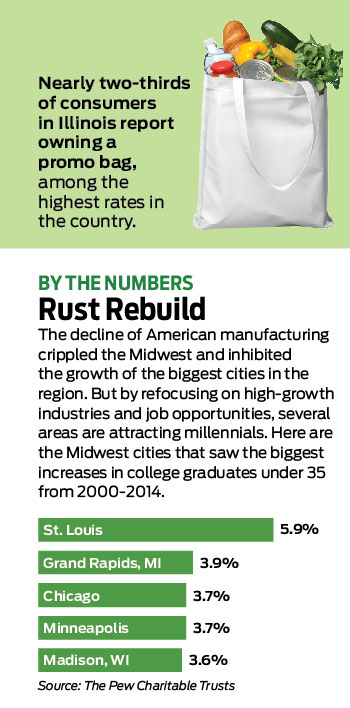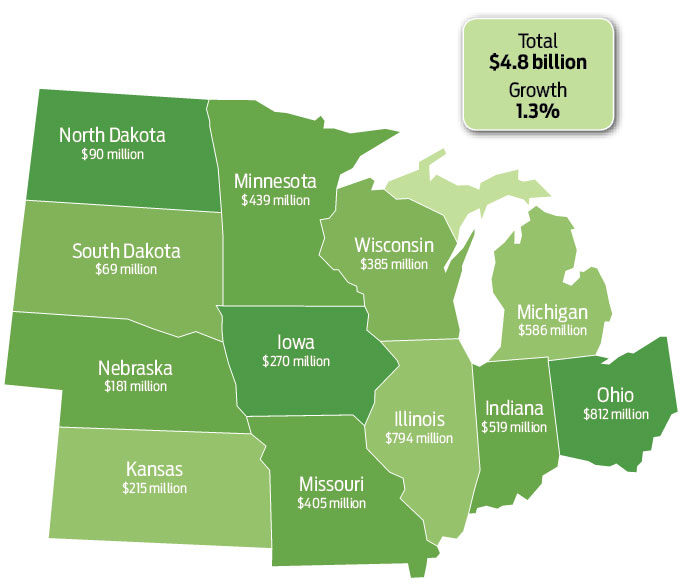April 21, 2017
Promotional Product Sales Report: Midwest
While staid on the surface, shifting dynamics underneath are recasting the future of the Midwest.
 n the Midwest, stability, reliability and a sense of the traditional are the qualities that help sustain industries. But for distributors in this region, changes in global economics and culture have eroded that comfortable self-identity, and the distributors who find themselves growing in 2017 are the ones who’ve embraced this sometimes disorienting change.
n the Midwest, stability, reliability and a sense of the traditional are the qualities that help sustain industries. But for distributors in this region, changes in global economics and culture have eroded that comfortable self-identity, and the distributors who find themselves growing in 2017 are the ones who’ve embraced this sometimes disorienting change.
How? By reinventing themselves and refining their brand identity. And by doing so, they’ve honed the skills to help clients do the same.
Mark McCormack, owner of Identity Marketing Group (asi/229993) in Omaha, NE, explains what happens when a business lacks a strong identity. “They lose track of their own story,” he says. “They don’t have any way to maintain their brand. The problem is exacerbated when companies have 13 different vendors and one budget they have to spend from.” If each vendor views the client through its own narrow lens, identity is blurred and diluted – and sometimes forgotten, McCormack adds.
As regional distributors have learned how to re-establish their own image from mere purveyors of products to holistic makeover artists for wayward brands, it’s been their customers’ own loss of identity that’s provided some of the biggest opportunities. And these opportunities can’t be seized simply by undercutting your competition on price. “Creativity is what leads it,” McCormack insists. “As companies began slashing their art departments, thinking they could outsource it, they let go of their most creative staff.” Smart distributors have recognized this gap as their key to longevity in a remade industry.
>> State Spotlight: Steady Sales In Nebraska
Telling the story of a brand requires insightful partnerships and an understanding of how to maximize distributors’ unique experience, says Janie Gaunce, president of Grapevine Designs (asi/212829) in Lenexa, KS. “We help illuminate the client,” she says, “by taking their brand standards, doing the research, and bringing concepts back that reflect what the messaging should be, alongside the merchandise.” She often partners with ad agencies to help craft those messages, but it’s the modern distributor who is best equipped to marry the concept to the product, and do it under the constraints this industry is accustomed to.
“You can outsource logo drops all day long,” says Gaunce, “but you can’t outsource brand storytelling and the merging of that message with merchandise.” And if that brand’s message requires a thousand orange stress balls, then that’s what distributors should provide. “But it’s the ability to offer all the other concepting, and pull it all together – that’s where the rubber meets the road,” she says. “That’s our brand!”

An easy way for distributors to keep a firm grip on brand identity for clients is to do more. Sometimes that means more product lines, and sometimes that means more services beyond simply gathering and imprinting goods. “When we meet with a client, we market ourselves as a full service provider,” says Dean Manzetti, partner and sales director of the Columbus Regional Service Center of American Solutions for Business (asi/120075). “We show them an entire program that will make their job a lot easier. If your client is buying only one thing from you, that means she’s buying something else from another vendor, something you can provide just as easily. You don’t need eight different vendors for promo, apparel and print. If you have a relationship with the buyer, why isn’t she buying everything from you?”
>> Case Study: A Quirky Promo For New Mothers
Distributors are establishing relationships with every size and type of client, too. “We have a very diverse clientele ranging from small companies to large corporate organizations,” says Robin Heldman, co-owner of Direct Connect Printing and Digital Services (asi/303473) in Indianapolis. Similarly, when asked about her go-to sectors for clients, Joyce Engberg, manager of award services of Minneapolis’ MotivAction (asi/277725), reels off a list of industries that stretch from finance and tech to food service and agriculture.
MotivAction also embraced diversification in 2016 by rolling out PromotionCenter, a computer application that automates sales incentive programs by tracking progress and communicating with the participants.
“For us, it’s always been about diversification,” agrees McCormack. “Our business has always been more of an agency as opposed to just selling promo.”
Key Trends
Part of the Tech Conversation
It’s not the obvious choice, but the Midwest is experiencing something of a tech boom, as cities such as Springfield, IL, Des Moines, IA, and Omaha, NE, regularly jostle for top space on lists of the best American cities to work in technology. Investments made in the region by companies like Google, which chose Kansas City, MO, as the flagship city for its Google Fiber internet service, have paid off by creating a tech-friendly environment that continually draws in new players and capital.
“Kansas City is becoming quite a technology and science community,” says Janie Gaunce, president of Grapevine Design. “The cost of living is lower, major league and collegiate sports are a phenomenal draw and we’ve emerged as an artistic, hip city with pockets of culturalism that are very refreshing for new hires.” The influx of new tech-talent is helping to drive the region’s growth, which climbed in February to its highest level since April 2014, according to Creighton University’s Mid-America Business Conditions Index, a leading economic indicator for the region. It’s also helped Gaunce’s company find new clients in her own backyard. “We’ve greatly increased our customer base in our own city,” she says.
“There’s a lot of tech,” agrees Identity Marketing Group's Mark McCormack, who is based in Omaha. “Google’s across from us, Yahoo is here. The Midwest’s low cost of living keeps the younger set coming, too. You can afford to be a startup anywhere in the Midwest.”
Finance Still Pays
Financial companies have a strong presence in the region – most famously personified by billionaire investor Warren Buffett, chairman of multinational conglomerate holding company Berkshire Hathaway, who’s lived in the same five-bedroom Omaha home since 1958.
Not surprisingly, regional distributors count finance as one of the most important sectors from which to draw clients. “We’ve had a lot of success presenting the entire package,” says ASB's Dean Manzetti. Though initially his sales in finance were primarily “from the document side of the business,” he’s found that these customers are too valuable to court so narrowly. “We hadn’t pursued the print and apparel side of the business as much, but they buy a lot of that stuff, especially some of the larger financial institutions and credit unions,” he adds. After Manzetti realized his financial clients were so receptive, he helped his company create a standardized program to teach its sales associates throughout ASB how to approach their financial clients. “We’ve been concentrating on that pretty heavily,” he says.
McCormack points out how deep the finance industry is in the areas around his home base town of Omaha, and how it attracts other business. “They want to tie into the financial services that are here, and the strength of that industry,” he says. “Even the Farm Credit Services of America – that’s the type of business people might dismiss, but it’s the largest agricultural lender in the world.”
Kind Is Cool
The famed hospitality of the Midwest encompasses more than just being neighborly. It also helps drive clients’ desire to give back to their communities. “Clients are really responding to this,” says MotivAction's Joyce Engberg about the growing number of clients who opt for promotions with a charitable dimension. That can include working with a vendor who donates a portion of their profits to charity, or one whose products are made by a disadvantaged group that then shares in the proceeds.
Gaunce notices this trend in many of her clients, too, and credits some of it to the influence of the young upstarts moving to the region to take advantage of its affordability and tech-industry opportunities. “People are asking about sustainability and about vetting of vendors,” she says. “Companies are working with vendors that care about the environment and the workforce. Everybody seems to be involved in some way in trying to give back to the world.”
Gaunce feels this marks a change from the past. “When I got out of college, the only thing companies did was United Way,” she says. “Now we have entire companies who create products simply to give back. We’ve evolved as businesses tremendously.”
Chuck Zak is a contributing writer for Advantages

